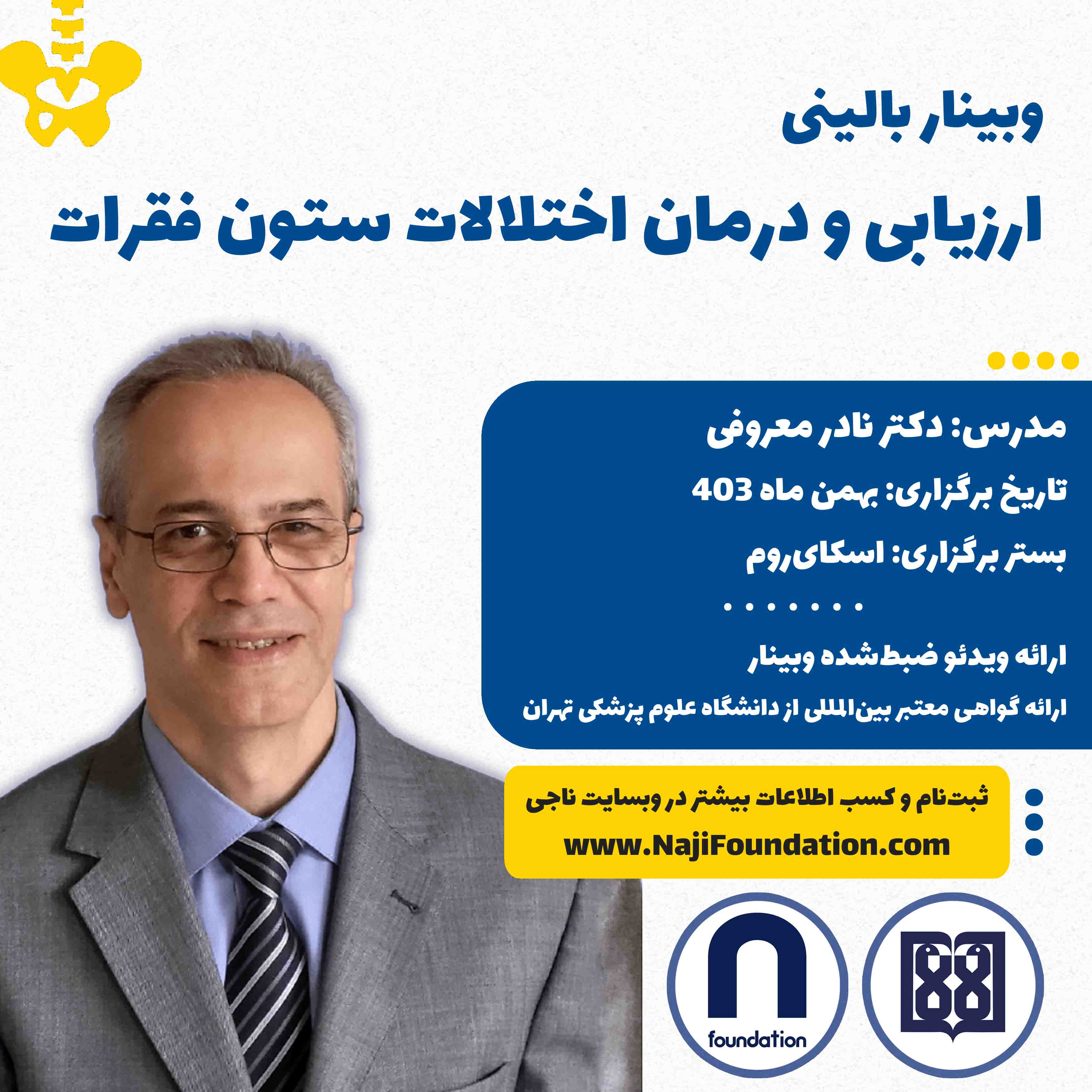
ارزیابی و درمان اختلالات ستون فقرات
مداخلات فیزیوتراپی نقش بسیار مهم و غیرقابل انکاری در درمان اختلالات ستون فقرات دارد. این اختلالات میتوانند شامل مشکلاتی مانند دیسکهای بینمهرهای، کمردرد، اسکولیوز و سایر مشکلات اسکلتی-عضلانی باشند.
- 6 شرکت کننده
- فیزیوتراپی
سطح اول
•
An overview of clinical biomechanics and functional anatomy of cervical spine
•
Cervical spine dysfunctions: mechanisms for articular derangements and MVT restriction
•
Screening tests for upper C-spine instability and vertebrobasilar artery insufficiency (VBI)
•
Assessment of cervical spine dysfunctions associated with muscle imbalance
•
Cervicogenic Headache (CGH): arthrogenic and myogenic sources
•
Application of MET techniques: managing head and neck misalignment, neck pain and stiffness, and headache-dizziness-nausea caused by C-spine articular dysfunctions and muscle imbalance
•
Integration of cervical-ocular reflexes and respiratory mechanics into MET interventions for enhanced therapeutic outcomes
•
Clinical decision-making strategies for selecting optimal MET parameters and ensuring patient safety in cervical interventions
سطح دوم
•
An overview of clinical biomechanics and chain reactions in the thoracic spine and rib cage
•
Thoracic spine and rib cage dysfunctions: mechanisms for articular derangements and muscle imbalances contributing to pain, MVT impairment, and breathing difficulties
•
Assessment of thoracic spine dysfunctions: diagnosing Neutral and Non-neutral Vertebral dysfunctions through palpation and MVT testing
•
Assessment of Rib dysfunctions: diagnosing inhalation and exhalation rib dysfunctions through palpation at 3 stages of breathing (quiet breathing, deep inhalation, deep exhalation)
•
Utilization of MET: managing thoracic pain and stiffness, correcting spinal alignment (including kyphosis and scoliosis), restoring spinal mobility, and enhancing respiratory function
•
Incorporation of inhalation and exhalation techniques to facilitate the 3-D release of myofascial restrictive barriers in the thoracic region, normalizing the affected T-spine and ribs mechanics
•
Consideration of precautions and contraindications in selecting appropriate MET parameters for thoracic interventions
سطح سوم
•
An overview of clinical biomechanics and pathomechanics of L-spine and pelvic girdle, lumbopelvic chain reactions, and mechanisms for articular derangements and MVT restrictions
•
Assessment of L-spine dysfunctions: Diagnosing Neutral and Non-neutral vertebral dysfunctions
•
Assessment of pelvic girdle dysfunctions: Diagnosing sacroiliac, iliosacral, and symphysis pubis dysfunctions through palpation and MVT testing, and in association with muscle imbalance
•
Implementation of MET interventions: Restoring lumbopelvic pain-free mobility, and optimizing gait mechanics
•
Emphasis on the role of respiratory mechanics in releasing myofascial restrictive barriers in the lumbar and pelvic regions
•
Clinical decision-making process in tailoring MET parameters to individual patient presentations and ensuring safety and efficacy in lumbar and pelvic interventions
تاریخ برگزاری:
- سطح اول (ستون فقرات گردنی + سردردهای سرویکوژنیک) : 5 بهمن ماه ساعت 20:45 الی 23:15
- سطح دوم (ستون فقرات توراسیک + اختلالات دندهای): 12 بهمن ماه ساعت 20:45 الی 23:15
- سطح سوم (ستون فقرات لومبار + اختلالات کمربند لگنی): 19 و 26 بهمن ماه ساعت 20:45 الی 22:45
نحوه نامنویسی:
- ابتدا نسبت به ساخت پنل کاربری و تکمیل اطلاعات خود در وبسایت ناجی اقدام بفرمایید.
- پس از احراز هویت شما توسط پشتیبانی، پیامک تایید برای شما ارسال میشود و میتوانید در دورههای مد نظر خود نامنویسی کنید.
- نحوه شرکت در وبینار را از طریق بخش "سوالات متداول" پنل کاربری خود مطالعه بفرمایید.
...........................................................................................
فیزیوتراپی نقش بسیار مهمی در درمان اختلالات ستون فقرات دارد. این اختلالات میتوانند شامل مشکلاتی مانند دیسکهای بینمهرهای، کمردرد، اسکولیوز و سایر مشکلات اسکلتی-عضلانی باشند. در زیر به برخی از جنبههای کلیدی نقش فیزیوتراپی در این زمینه اشاره میشود:
۱. ارزیابی و تشخیص
فیزیوتراپیستها با ارزیابی دقیق وضعیت بیمار، اطلاعات لازم درباره نوع و شدت اختلالات ستون فقرات را جمعآوری میکنند. این ارزیابی شامل تستهای حرکتی، قدرت عضلانی و انعطافپذیری میشود.
۲. برنامهریزی درمانی
پس از ارزیابی، فیزیوتراپیست یک برنامه درمانی شخصیسازیشده طراحی میکند که شامل تمرینات تقویتی، کششی و بهبود وضعیت قرارگیری بدن است.
۳. کاهش درد
فیزیوتراپی میتواند به کاهش درد ناشی از اختلالات ستون فقرات کمک کند. تکنیکهای مختلفی مانند درمان دستی، الکتروتراپی و استفاده از یخ یا گرما برای کاهش التهاب و تسکین درد به کار میروند.
۴. تقویت عضلات
تمرینات تقویتی برای تقویت عضلات پشتی و شکمی اهمیت زیادی دارند. این عضلات از ستون فقرات حمایت کرده و میتوانند به بهبود وضعیت بدن و کاهش فشار ناشی از اختلالات کمک کنند.
۵. بهبود انعطافپذیری
فیزیوتراپی شامل تمرینات کششی است که به بهبود انعطافپذیری مفاصل و عضلات کمک میکند. این امر میتواند به حرکت بهتر و کاهش خطر آسیب کمک کند.
۶. آموزش
فیزیوتراپیستها به بیماران آموزش میدهند که چگونه وضعیت بدنی خود را بهبود بخشند و از حرکات نادرست جلوگیری کنند. این آموزشها شامل تکنیکهای صحیح نشستن، ایستادن و بلند کردن اشیاء میشود.
۷. پیشگیری از عود
فیزیوتراپی به بیماران کمک میکند تا با یادگیری تمرینات مناسب و تغییر عادات روزمره، از عود مجدد مشکلات ستون فقرات جلوگیری کنند.
۸. بازگشت به فعالیتهای روزمره
فیزیوتراپی به بیماران کمک میکند تا به فعالیتهای روزمره و ورزشی خود بازگردند. این امر میتواند کیفیت زندگی آنها را بهبود بخشد.
نتیجهگیری
فیزیوتراپی به عنوان یک روش غیرجراحی و موثر در درمان اختلالات ستون فقرات شناخته میشود. با برنامهریزی مناسب و همکاری بیمار، میتوان به نتایج مثبت و بهبودی قابل توجهی دست یافت.
دیدگاه کاربران
ثبت دیدگاه
دیدگاه خود را راجع به این مقاله ثبت کنید.قیمت دوره
850,000 - 2,890,000 تومان
مشخصات دوره
- نوع دوره وبینار بالینی
-
تاریخ برگزاری
5 ، 12 ، 19 ، 26 بهمن
- مکان برگزاری بستر وبیناری اسکایروم
- ساعت برگزاری توضیحات مطالعه شود
- نوع پرداخت نقدی
دکتر نادر معروفی
دانشیار گروه فیزیوتراپی دانشگاه علوم پزشکی ایران
- 4.5/5.0


